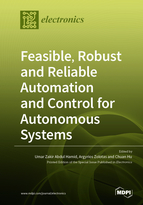Feasible, Robust and Reliable Automation and Control for Autonomous Systems
A special issue of Electronics (ISSN 2079-9292). This special issue belongs to the section "Systems & Control Engineering".
Deadline for manuscript submissions: closed (30 April 2022) | Viewed by 33429
Special Issue Editors
Interests: advanced sriver assistance systems (ADAS); guidance, navigation & control for autonomous vehicle (GNC); motion, mission & path planning; risk assessment; collision avoidance; nonlinear optimal control; and model-based simulations
Special Issues, Collections and Topics in MDPI journals
Interests: autonomous systems; mechatronics & advanced controls; vehicle health management
Interests: decision-making; motion planning and control of autonomous vehicles; human-vehicle interaction; trust dynamics; shared control; ADAS; dynamics and control; state and parameter estimations; mechatronics
Special Issue Information
Dear Colleagues,
The past few decades have seen a rapid development towards autonomous systems. Increasing computational power ability and advances in new computing devices nowadays allow for feasible real-time implementation of autonomous systems. This has been further supported by large scale research in autonomous systems applications, including (but not limited) ground, aerial, maritime vehicles, mobile robotics. Different to automated systems, an autonomous system employs situational awareness information, via perception modules, used by the (normally) multi-layer control strategy to command the effectors driving the system. Given that the real world consists of dynamic and varied conditions environment, a reliable control strategy for autonomous systems should offer a safe, reliable, robust solution. Thus, in this proposed special issue on ‘Feasible, Robust and Reliable Automation and Control for Autonomous Systems’, the aim is to have wider dissemination of the control strategy topics for multiple types autonomous systems not constrained to a single platform. The special issue aims to highlight current research in the control field for autonomous systems, as well as showcasing the state-of-the-art control strategy approaches for the autonomous platforms. We strongly believe this special issue call will strongly appeal to control systems related researchers in applications typified in the fields of ground, aerial, maritime vehicles and robotics. Thus, this special issue aims to reflect on the most recent progress of control strategy for autonomous platforms, where the potential topics include, but are not limited to:
- Control System Design for Autonomous Systems (Road Vehicles, Mobile Robots, Autonomous Surface Vehicles, Autonomous VTOL, Autonomous Machinery).
- Vehicle and Mobile Robotics Automation
- Robustness Analysis of Control Strategy Performance of Autonomous Systems
- Kinematics, Dynamics and Model Nonlinearity effects to the controller performance of the Autonomous Systems
- Path, trajectory and motion tracking performance of control strategy for autonomous systems in varied conditions
- Real-time comparisons of controller performances for Autonomous Systems
- Stability analysis of the controller performance for autonomous systems
- Gain analysis of the control strategy for autonomous systems
- Performance Assessment methods for control system performance of autonomous systems
- Real-Time Validation of multi-objective dynamic Control Strategy Performance of an autonomous system
- State estimation for autonomous system control strategy
- Disturbances for autonomous platforms control systems
- Control strategies for autonomous platforms in uncertain environments
- Optimal and nonlinear control strategy for autonomous systems such as Model Predictive Control, H-infinity, Sliding Mode Control and Linear-quadratic control.
- High-level and low-level controller design and implementation for autonomous systems.
- Control Systems for Robotics Automation
Prof. Dr. Argyrios Zolotas
Assist. Prof. Dr. Chuan Hu
Guest Editors
Manuscript Submission Information
Manuscripts should be submitted online at www.mdpi.com by registering and logging in to this website. Once you are registered, click here to go to the submission form. Manuscripts can be submitted until the deadline. All submissions that pass pre-check are peer-reviewed. Accepted papers will be published continuously in the journal (as soon as accepted) and will be listed together on the special issue website. Research articles, review articles as well as short communications are invited. For planned papers, a title and short abstract (about 100 words) can be sent to the Editorial Office for announcement on this website.
Submitted manuscripts should not have been published previously, nor be under consideration for publication elsewhere (except conference proceedings papers). All manuscripts are thoroughly refereed through a single-blind peer-review process. A guide for authors and other relevant information for submission of manuscripts is available on the Instructions for Authors page. Electronics is an international peer-reviewed open access semimonthly journal published by MDPI.
Please visit the Instructions for Authors page before submitting a manuscript. The Article Processing Charge (APC) for publication in this open access journal is 2400 CHF (Swiss Francs). Submitted papers should be well formatted and use good English. Authors may use MDPI's English editing service prior to publication or during author revisions.
Keywords
- Control Strategy for Autonomous Systems
- Control Systems for Autonomous Robots
- Control Systems for Autonomous Vehicles
- Control Systems for Autonomous VTOL
- Performance Assessment for Control Systems
- Robustness and Stability for Control Systems
- Nonlinear systems
- Multi-objectives control
- Autonomous control systems for uncertain environments
- Control strategy design, implementation and validation for autonomous robots’ platforms








